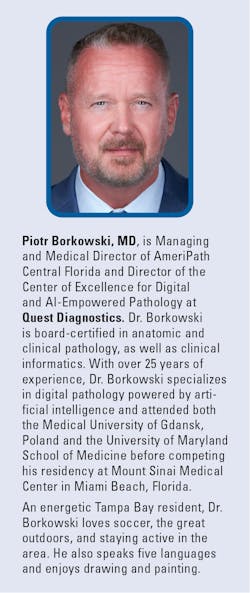I believe that, when we review a biopsy under a microscope, every pathologist’s greatest hope is to find no cancer, or to be able to make a very early cancer diagnosis. We know that early detection of cancer often leads to the best treatment outcomes. However, the COVID-19 pandemic created and fostered an environment where the diagnosis and treatment of cancer were both delayed. A Quest Diagnostics Health Trends study by some of my colleagues found even after two years, cancer diagnosis has not returned to pre-pandemic rates for breast and prostate, two of the most common cancers. We are likely to see the impacts of the pandemic for years to come.
What advice do you have to improve the pathologist—clinician collaboration?
Effective collaboration between the clinician and the pathologist leads to the best patient care. Both must be willing to work together and have clear and direct lines of communication. The increased use of virtual technologies like Zoom over the last few years has assisted this and helped both parties talk directly as much as possible — literally face to face. I have been doing this myself for a few years now and believe it makes me a more well-rounded physician. There is information both clinicians and pathologists can learn from each other, making both parties medically ‘bilingual.’ As an example, it is important for pathologists to learn as much as possible about the clinical aspect of the disease such as any advances in treatments or clinical trials, and it is equally as important for clinicians to learn about diagnostic aspects from pathologists.
How are AI-based approaches expanding the treatment of cancer?
This is a very exciting time to be in the field of pathology. We are currently integrating artificial intelligence (AI) into the diagnosis of some cancer types at Quest Diagnostics, which I find very interesting. I believe in the near future AI will be integrated into the pathologist’s workflow, and I am honored and energized to be part of the team leading that cause at Quest Diagnostics. Specifically, AI has the potential to assist in tumor detection, tumor grading, and classification. It is also expected to play a role in the prediction of mutations, survival, and therapy response solely based on H&E-derived computational data. Integrating AI into the diagnosis of cancer, and then using AI to assist in determining the most optimal treatment, is a groundbreaking advancement. This can – and I believe will – save many lives by directing clinicians to the best treatment, for the best outcome, from the start of a patient’s cancer journey. We also have used AI in cytotechnology to significantly hasten our results reporting for some applications, namely the chromosome analysis procedure, which is known to be a highly manual process. By using AI to make this step more efficient and analyze chromosomes faster, we were able to eliminate backlogs and improve consistency of turnaround times.
What do you think the future holds for personalized medicine in the next 5–10 years?
The last few years have led to some large changes in the field of pathology. Many have experienced this twice before, through the introduction of immunohistochemistry and genomics. I believe we are experiencing a third revolution in pathology with the introduction of digital and AI-empowered pathology. Though I have been in this field for over twenty years, this is the most exciting time of my career, creating big changes that bring with them big opportunities. The opportunity to improve and optimize care via personalized medicine is before us, and it is my belief that we will continue to see important developments and advancements in how the patient interacts and receives information and care from his or her physician. With these new advancements, patients can expect improved care — leading to better outcomes and improved health.
What challenges do you face in your everyday work?
The integration of artificial intelligence (AI) and digital pathology software into the workflow is a current challenge that I find very intriguing. My approach is to take my experience as a pathologist and tweak the digital software so that the workflow becomes seamless, thereby creating an environment where adoption by the pathologists I work with is made easy. I look forward to the ways this technology will continue to evolve and present new, unique, and interesting challenges to my work.


